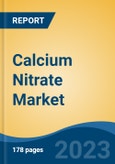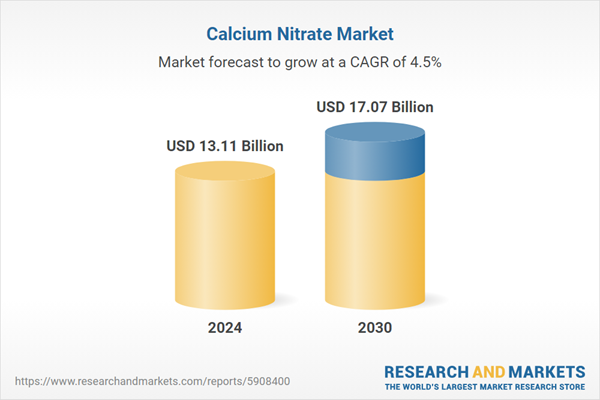Speak directly to the analyst to clarify any post sales queries you may have.
10% Free customizationThis report comes with 10% free customization, enabling you to add data that meets your specific business needs.
Moreover, beyond its significance in agriculture, calcium nitrate finds multifaceted applications in various industries. Its commercial distribution extends to sectors such as the synthesis of explosives, wastewater treatment, pharmaceutical manufacturing, and cement production. Furthermore, its utility extends to water treatment, including municipal water treatment, and even as an effective agent to eliminate unpleasant odors in tissues. With its diverse range of applications, calcium nitrate proves to be a versatile compound that plays a pivotal role in multiple fields, making it an indispensable component in numerous industrial processes.
Key Market Drivers
Growing Demand of Calcium Nitrate for Fertilizers
The global surge in demand for calcium nitrate is primarily attributed to its expanding role in the fertilizer industry, where it serves as a reliable, water-soluble nutrient source for plants. Its dual composition of nitrogen and calcium supports critical growth functions and enhances soil fertility. The adoption of calcium nitrate-based fertilizers has gained momentum due to their fast nutrient delivery and compatibility with modern irrigation systems. According to a 2024 survey, over 65% of commercial greenhouse farmers globally reported using calcium nitrate in their nutrient management practices.As the global population continues to rise, agricultural output must keep pace to ensure food security. This necessity has prompted increased use of fertilizers that promote higher crop productivity. Calcium nitrate aids in faster nutrient absorption and minimizes soil salinity, which is vital for maintaining long-term soil health. A 2023 report indicated that crops treated with calcium nitrate witnessed up to a 17% increase in yield compared to those treated with conventional nitrogen sources. This makes it a preferred choice for both open-field and protected cultivation systems.
Another factor driving its demand is the global shift toward sustainable farming. Nitrate-based fertilizers, such as calcium nitrate, are known for their reduced environmental footprint. Unlike urea-based fertilizers, they release minimal greenhouse gases and offer better leaching control. This aligns well with global sustainability goals and the agricultural industry's transition to eco-friendly inputs. As climate-smart agriculture gains prominence, the use of calcium nitrate is expected to intensify, especially in regions dealing with soil degradation and water scarcity.
Key Market Challenges
Increasing Use of Organic-Based Fertilizers
The shift towards organic-based fertilizers is anticipated to significantly impede the global demand for calcium nitrate in the coming years. As growing concern surrounds the environmental and health impacts of chemical-based fertilizers like calcium nitrate, the agricultural industry has been gradually transitioning to more sustainable and eco-friendly alternatives. The use of organic-based fertilizers, derived from natural materials like plant wastes or animal manure, has risen sharply.This surge can be attributed to their manifold benefits, such as improving soil health, promoting sustainable farming, and reducing water pollution. Organic fertilizers also impact crop yield positively, as they slowly release nutrients, boosting long-term soil fertility. This trend is further bolstered by supportive government policies encouraging organic farming and consumer preference for organic produce. Consequently, as organic-based fertilizers become more prevalent, the demand for calcium nitrate, a once dominant player in the fertilizer market, is projected to decrease, marking a significant shift in agricultural practices worldwide.
Key Market Trends
Expanded Usage in Greenhouse Cultivation
The global demand for calcium nitrate is anticipated to rise, largely driven by an increase in greenhouse cultivation practices. As agricultural focus turns towards sustainable and efficient methods, greenhouse cultivation has emerged as an effective solution. Calcium nitrate plays a pivotal role in this scenario. It is a multi-functional fertilizer that not only provides essential nutrients for the plant's growth but also improves the quality of the yield. In a controlled environment such as a greenhouse, calcium nitrate proves exceptionally beneficial, enhancing the plant's absorption of sunlight, accelerating germination, and combating diseases.With an increasing global population leading to heightened food demand, the need for high productivity farming methods is more crucial than ever. This, in turn, escalates the demand for calcium nitrate. Additionally, the shift towards hydroponics - a soil-less growing technique that heavily relies on nutrient solutions like calcium nitrate - further propels its global demand. Thus, the expanding usage in greenhouse cultivation, coupled with the rising adoption of advanced farming techniques, is set to significantly boost the global demand for calcium nitrate.
Key Market Players
- Agrium Inc.
- Yara International ASA
- Sterling Chemicals Company
- Gfs Chemicals Inc.
- Haifa Group
- Uralchem Holding Plc
- Rural Liquid Fertilisers
- Shanxi Jiaocheng Tianlong Chemical Industry Co. Ltd.
- Prochem Inc.
- UralChem Holding P.L.C.
Report Scope:
In this report, the Global Calcium Nitrate Market has been segmented into the following categories, in addition to the industry trends which have also been detailed below:Calcium Nitrate Market, By Application:
- Fertilizers
- Wastewater Treatment Chemicals
- Concrete Manufacturing
- Explosives
- Others
Calcium Nitrate Market, By Process:
- Limestone with Nitric Acid
- Phosphate Rock with Nitric Acid
- Ammonium Nitrate with Calcium Hydroxide
Calcium Nitrate Market, By Grade:
- Agriculture
- Greenhouse
- Horticulture
- Liquid
- Industrial
Calcium Nitrate Market, By Region:
- North America
- United States
- Canada
- Mexico
- Europe
- France
- United Kingdom
- Italy
- Germany
- Spain
- Asia-Pacific
- China
- India
- Japan
- Australia
- South Korea
- South America
- Brazil
- Argentina
- Colombia
- Middle East & Africa
- South Africa
- Saudi Arabia
- UAE
Competitive Landscape
Company Profiles: Detailed analysis of the major companies present in the Global Calcium Nitrate Market.Available Customizations:
With the given market data, the publisher offers customizations according to a company's specific needs. The following customization options are available for the report.Company Information
- Detailed analysis and profiling of additional market players (up to five).
Table of Contents
Companies Mentioned
- Agrium Inc.
- Yara International ASA
- Sterling Chemicals Company
- Gfs Chemicals Inc.
- Haifa Group
- Uralchem Holding Plc
- Rural Liquid Fertilisers
- Shanxi Jiaocheng Tianlong Chemical Industry Co. Ltd.
- Prochem Inc.
- UralChem Holding P.L.C.
Table Information
| Report Attribute | Details |
|---|---|
| No. of Pages | 180 |
| Published | August 2025 |
| Forecast Period | 2024 - 2030 |
| Estimated Market Value ( USD | $ 13.11 Billion |
| Forecasted Market Value ( USD | $ 17.07 Billion |
| Compound Annual Growth Rate | 4.4% |
| Regions Covered | Global |
| No. of Companies Mentioned | 10 |









